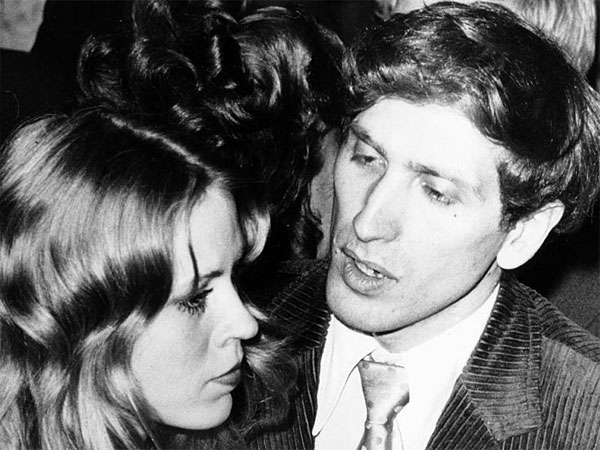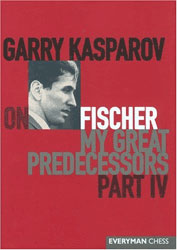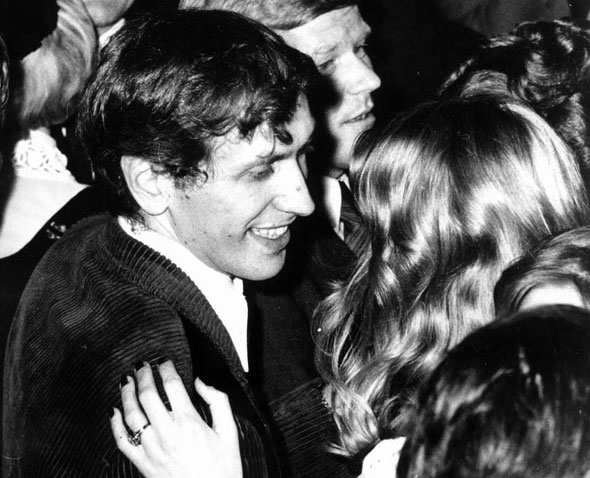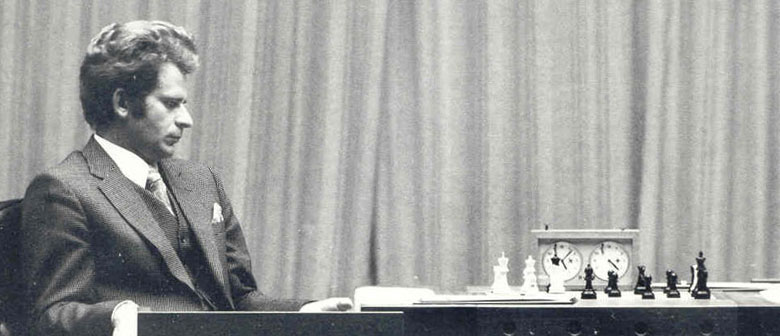


On August 25th 1972, the adjournment of the 18th game ended, and Fischer still had his three-point lead. Things were getting alarming close for World Champion Spassky.

Here are some general impressions of Fischer's strength and style, given by his contemporaries (as quoted in Garry Kasparov On My Great Predecessors, Part 4):

Viktor Korchnoi: Fischer's main strength is his versatility. In his style a striving for the initiative and "respect for material" are harmoniously combined. He can sacrifice material for an attack, but he can also accept a sacrifice and engage in a difficult defence. Fischer has mastered the psychological method of preparation, selecting combat methods beforehand. Even so, one gains the impression that in a strategic battle he is not so strong, and lengthy positional manoeuvring tires or bores him.
Lev Polugayevsky: When Fischer knows what he has to do, he plays very accurately. But if the position is of a non-concrete nature, Fischer often loses the thread and plays planlessly. In contrast to a number of grandmasters, for Fischer it is not typical to change his plan during the course of a game (for the moment he still lacks the necessary flexibility in choice of plan). Fischer is obstinate in the accomplishment of his goal, even if it is faulty.
Efim Geller: Both in the opening, and in the middlegame, Fischer's main strength is that he quickly and excellently solves simple functions. It would appear that he has this "in his blood". He does not devise deep plans, but leaps from position to position. This is what comprises Fischer's style. His play is clear and transparent. It is not hard to guess Fischer's intentions, but it is more difficult to counter them, since his decisions are sensible and practical.
Boris Spassky (after the Piatigorsky Cup in Santa Monica 1966, where he had finished first, half a point ahead of Fischer, and drawn his game against the American): Fischer is a very talented player: he has interesting chess ideas, and in his style he resembles Capablanca. Fischer has an excellent knowledge of opening theory, but he feels less confident in unfamiliar set-ups. After the rounds I often met the American grandmaster. We established friendly relations. I saw how wholeheartedly Fischer loves chess. One even gains the impression that without chess he is lonely...
Brad Darrach, journalist and film critic, spent more time with Bobby Fischer than any other journalist. During the match in Iceland he was (as he claims in his book), "in constant contact with Bobby and his staff." Darrach wrote extensively for Life, Playboy, Esquire, Harper's and other magazines. In Bobby Fischer vs. the Rest of the World, he wrote:
After the eighteenth game, Bobby began to emerge from the groggy lull of the hot-pot era. He had found two (count 'em) two gorgeous Icelandic girl friends. The girls were both seventeen years old. Inga was tall, slender and blond with long legs and a pleasant girlish figure. Anna was somewhat shorter and bustier.
The romance had begun for the girls when they first saw Bobby's picture in the paper. "He's so handsome!" they had agreed. One day they waited several hours in the rain until Bobby arrived at the playing hall. Bobby didn't let himself get too friendly. "Gotta be careful, you know, till the match is over!"

Black-and-white photos courtesy of the Icelandig Chess Federation Skáksamband Íslands
In Chess Life & Review January 1973, p. 17, Robert Byrne wrote:
Redoubled efforts by Boris Spassky to lop a point from the challenger's lead made for brilliant, hard-fought chess in the next stage of the match, which saw Fischer inching nearer and nearer to victory with draws in games 18, 19 and 20. Was Bobby content merely to sneak in by split points? I don't believe it — it's never been his style. I think the explanation for the draws is to be found in Spassky's improvements in his openings.
In games 18 and 20, Boris returned to the Sicilian Defense which worked well for him in game 4. On the strength of the latter game, in which Spassky discovered an excellent way to handle Fischer's 6.Bc4, Bobby was constrained to go over to 6.Bg5, entering into positions unfamiliar to him. The 18th contest was a great struggle in which Black's chances were never inferior to White's, and, in the 20th game, Fischer made no attempt to refute the defense, acceding to an early equality by Black.
The strongest blow Spassky struck in the entire match was his knocking out Fischer's favorite Najdorf Sicilian in games 11 and 15. That forced Bobby to run to the Pirc-Robatsch and Alekhine's Defenses; the former he had never played before, and the latter he had used very sparingly as his second string. The Alekhine's Defense in game 19 gave rise to a carnage of scintillating sacrifices, ending wondrously on level terms.
Still, all Spassky's ingenuity came to naught against Fischer's superior play. At the end of game 20, Boris continued to trail by 3 points, with the score 11½–8½.

The book Bobby Fischer Goes to War by David Edmonds and John Eidinow, first edition 2004 by Harper Collins, describes the mood of the Soviet side at this stage of the match:
By the time he arrived in Reykjavik, Spassky was feeling the strain caused by the breakdown of two key relationships during his training period, one with the director of the Central Chess Club, Viktor Baturinskii, the other with the champion’s personal coach, Igor Bondarevskii. There was also a quarrel with Mikhail Botvinnik, opening a rift sufficiently wide for Botvinnik to refuse to sign a petition to save the struggling magazine Moscow Chess from closure simply because Spassky’s signature was also on it.
The consequences of the breach with Baturinskii, in particular, were to be serious. Spassky put at arm’s length the man who had direct responsibility for chess and chess players, who led the negotiations with the Americans and with FIDE over the location of the match, and who might have been a highly effective team leader in Iceland.
The immediate cause of this dispute appears trivial. Spassky wanted to lend his car to a friend. To do this, he needed a duly notarized letter of authority (as is still the case in Russia today). In late November 1971, Spassky drafted such a letter and asked Baturinskii to affix the Central Chess Club seal and countersign it. Baturinskii refused. He was not qualified to sign, he told Spassky. (Actually, he thought there was something suspect about the document and believed Spassky would do better to take it to a lawyer.) The champion took this as a personal slight and made it plain that as far as he was concerned, Baturinskii was no longer to be trusted. From this point on, Baturinskii was effectively excluded from close contact with the preparations.
The row undoubtedly upset Spassky and drained his energy. Bondarevskii told Ivonin that he and Spassky could no longer work together and they had come to an amicable agreement to part. Since he became champion, Spassky had practically ceased to listen to his recommendations. Nor was Bondarevskii satisfied with Spassky’s work rate. ‘It’s impossible to work with him, impossible. I am standing down. He doesn’t follow my instructions: he gets on with all sorts of other things. With so little time before the match he can’t concentrate.’
Some believe that Bondarevskii abandoned the team because he feared his trainee was heading for defeat and was apprehensive of being associated with failure.
We bring you excerpts of Byrne's commentary on game 20, in which according to Garry Kasparov in My Great Predecessors, Part 4 "a quiet, roughly equal endgame was quickly reached. Spassky then gained some advantage, but again nothing came of it."
Here are the times for games nineteen and twenty, as recorded by Lawrence Stevens, who visited the match in Reykjavik and jotted them down from the video screens:
|
Game 19, August 27th, 1972 Spassky Fischer |
Game 20, August 29 + 30, 1972 Fischer Spassky To me, the activity at the board looked like Fischer was going to claim a draw by repetition with 55. Kd2, but Spassky agreed to the implied draw offer before it could be shown that the position had not yet been repeated 3 times. |
On August 30th 1972, exactly 45 years ago, the adjournment of the 20th game ended, and Fischer still had his three-point lead.

Bobby Fischer in Iceland – 45 years ago (1)
In the final week of June 1972 the chess world was in turmoil. The match between World Champion Boris Spassky and his challenger Bobby Fischer was scheduled to begin, in the Icelandic capital of Reykjavik, on July 1st. But there was no sign of Fischer. The opening ceremony took place without him, and the first game, scheduled for July 2nd, was postponed. Then finally, in the early hours of July 4th, Fischer arrived. Frederic Friedel narrates.
Bobby Fischer in Iceland – 45 years ago (2)
The legendary Match of the Century between Boris Spassky and Bobby Fischer was staged in the Laugardalshöllin in Reykjavik. This is Iceland’s largest sporting arena, seating 5,500, but also the site for concerts – Led Zeppelin, Leonard Cohen and David Bowie all played there. 45 years after the Spassky-Fischer spectacle Frederic Friedel visited Laugardalshöllin and discovered some treasures there.
Bobby Fischer in Iceland – 45 years ago (3)
On July 11, 1992 the legendary Match of the Century between Boris Spassky and Bobby Fischer finally began. Fischer arrived late, due to heavy traffic. To everybody's surprise he played a Nimzo instead of his normal Gruenfeld or King's Indian. The game developed along uninspired lines and most experts were predicting a draw. And then, on move twenty-nine, Fischer engaged in one of the most dangerous gambles of his career. "One move, and we hit every front page in the world!" said a blissful organiser.
Bobby Fischer in Iceland – 45 years ago (4)
7/16/2017 – The challenger, tormented by the cameras installed in the playing hall, traumatically lost the first game of his match against World Champion Boris Spassky. He continued his vigorous protest, and when his demands were not met Fischer did not turn up for game two. He was forfeited and the score was 0-2. Bobby booked a flight back to New York, but practically at the very last moment decided to play game three – in an isolated ping-pong room!
Bobby Fischer in Iceland – 45 years ago (5)
7/21/2017 – After three games in the Match of the Century the score was 2:1 for the reigning World Champion. In game four Spassky played a well-prepared Sicilian and obtained a raging attack. Fischer defended tenaciously and the game was drawn. Then came a key game, about which the 1972 US Champion and New York Times and Chess Life correspondent GM Robert Byrne filed reports. In Reykjavik chess fan Lawrence Stevens from California did something extraordinary: he manually recorded the times both players had spent on each move.
Bobby Fischer in Iceland – 45 years ago (6)
7/26/2017 – In the sixth installment of our series we offer readers a glimpse of what had been happening behind the scenes of “The Match of The Century”, especially in the Russian camp. A tense Boris Spassky, cajoled by seconds Efim Geller and Nikolai Krogius, nevertheless failed to perform to the dismay of his friends and admirers. It’s also the story of a gamble that could have hurtled Bobby down the precipice in that fateful Game 6 of the match. A cautionary tale and object lesson for aspiring players.
Bobby Fischer in Iceland – 45 years ago (7)
8/4/2017 – After the first two traumatic games World Champion Boris Spassky was leading 2-0 in the Match of the Century. But then Fischer started to play and struck back: in the next eight games he scored 6½ points, chalking up a 6.5-3.5 lead. Games 8, 9 and 10 were quite spectacular, and are the subject of today's report. Younger players will also learn about "adjournments" and how exactly "sealed moves" were handled. Some were born after these practices were abandoned.
Bobby Fischer in Iceland – 45 years ago (8)
8/9/2017 – After ten games in the World Championship match in Reykjavik, 1972, the score was 6½-3½ for Challenger Bobby Fischer. The match seemed virtually over – in the last eight games Boris Spassky had only managed to score 1½ points. "If it had been the best of 12 games, as in the Candidates matches, Spassky would already have been on his way home..." wrote Garry Kasparov in his Great Predessors book. In game 11 Boris took on the Poisoned Pawn variation of the Najdorf Sicilian, even though he had obtained a lost position in game seven. Take a look at what happened.
Bobby Fischer in Iceland – 45 years ago (9)
8/11/2017 – In game eleven of the World Championship match in Reykjavik, 1972, Boris Spassky had comprehensively outplayed the challenger in his favourite poisoned pawn variation of the Sicilian Defence. In game 12 he made a confident draw with black and Fischer realized his opponent was gaining ground. In the 13th game he abandoned the Sicilian and, to the chagrin of Spassky, played, for the first time in a top-level game – the Alekhine Defence. It turned into one of the most exciting battles of the match, and is beautifully annotated by GM Robert Byrne.
Bobby Fischer in Iceland – 45 years ago (10)
8/18/2017 – The Match of the Century was coming to a head, with Spassky, but despite all his efforts, unable to reduce the deficit. "I felt that Fischer was like a large fish in my hands," he lamented, "one that was slippery and hard to hold on to. At certain moments I let him slip. And then again the psychological torment would begin. Everything had to be begun again from the start ..." Spassky was beginning to feel despondent.
Bobby Fischer in Iceland — 45 years ago (11)
8/25/2017 – After draws in games 14 and 15, Fischer still had a three-point lead in the World Championship match, and the Spassky side was getting nervous. The Champion was fighting hard but not getting any points. Suspicion arose that Fischer might be using secret weapons: hypnosis, devices planted in the lights or the chairs, and even perhaps assistance from an "IBM" (Russian for "computer" at the time). All this was formally investigated, while Fischer continued to coast.